Learning what the triceps brachii does helps you to maximize your results in the gym. For example, knowing that the long head of the triceps (the biggest head) is most active when your shoulders are in flexion, you come to the realization that overhead extensions are a vital exercise for maximizing your triceps development.
We’ve covered the kneeling cable tricep extension (and its many variations) in a different article.
This guide, however, is all about the dumbbell kneeling tricep extension. You’ll learn how to perform all 4 variations for the best results and then find out how the exercise can benefit your body.
Kneeling dumbbell tricep extension exercise details
- Also Known As: Kneeling DB tricep extension
- Main Muscles: Triceps
- Exercise Type: Strength
- Exercise Mechanics: Isolation
- Difficulty Level: Intermediate
- Equipment Needed: Dumbbell
How to do a kneeling dumbbell overhead tricep extension
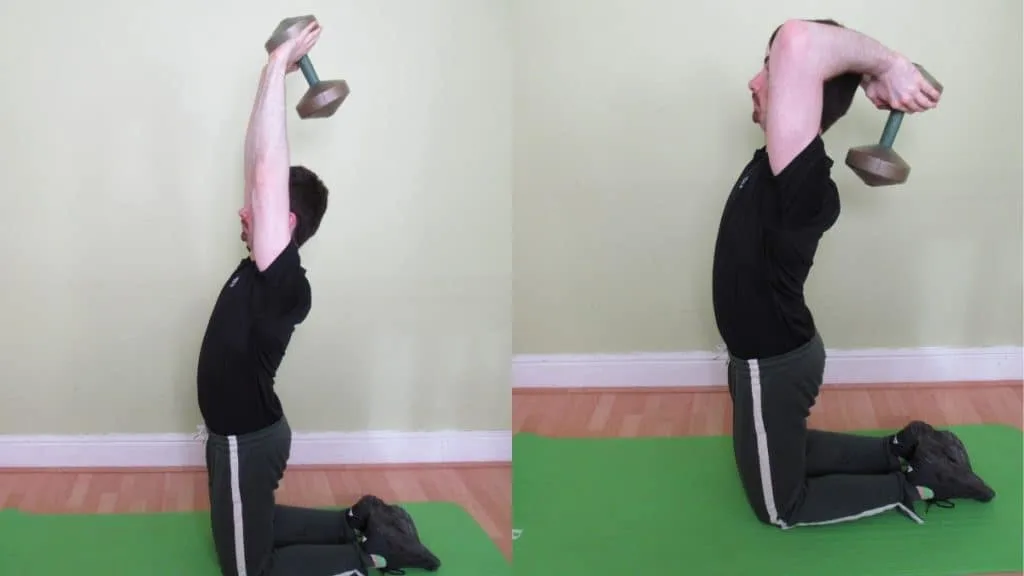
- Place an exercise mat on the floor and grab a moderately heavy dumbbell.
- Assume a tall kneeling position in which your hips are fully extended and your spine is straight.
- Cup your hands around one end of the dumbbell and press it over your head.
- Tuck your elbows in slightly, and then lower the weight behind your head by “breaking” at your elbows.
- Descend until you feel an intense stretch in the backs of your arms.
- Reverse the movement by flexing your triceps forcefully until your elbows reach complete extension.
- Repeat for 3-5 sets of 10-20 reps.
Kneeling dumbbell overhead extension variations
You can modify the kneeling overhead extension to make it more triceps-focused or more core dominant. Learn which option is best for you in these tutorials.
One arm kneeling tricep extension
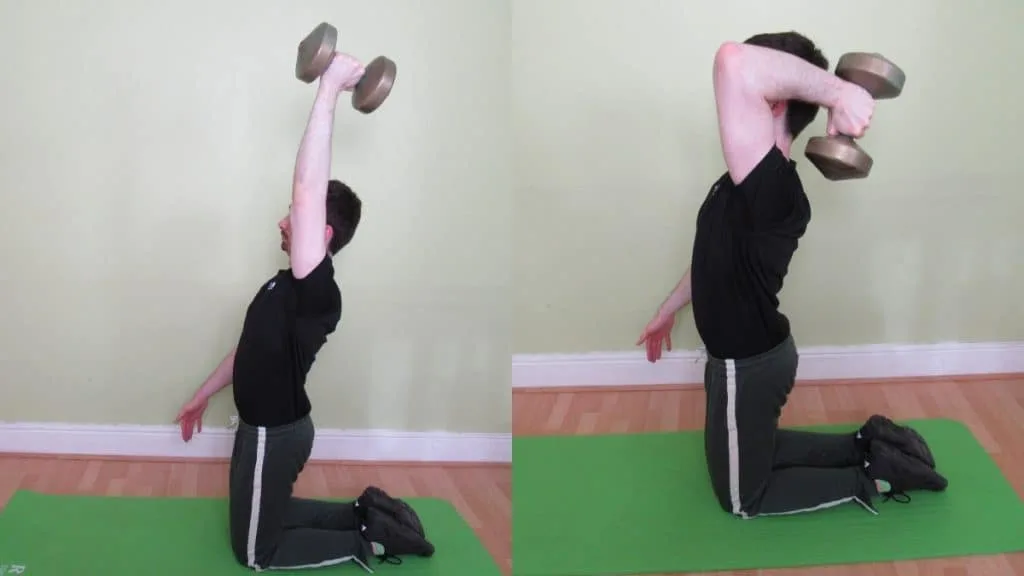
The kneeling single arm tricep extension has the exact same lifting technique as the standard version; you lower the dumbbell behind your head in a controlled manner (while in a tall kneeling position) and then flex your triceps to lift the weight back up.
Training each arm separately, however, reduces the burden on your core muscles and thus makes it easier to focus on training your triceps. This is because you won’t need to brace your abs as hard to stabilize your torso now that you’re lifting less total weight.
Additionally, training your triceps unilaterally promotes the development of upper arm symmetry as well as upper arm mass. By giving each arm equal amounts of work, you can feel confident that both of your triceps will be growing at similar rates, which in turn helps you to avoid (or reduce) any muscular imbalances.
Training each triceps muscle separately will, of course, take a bit longer. So if you’re in a rush, you might want to stick with bilateral (two-arm) exercises like barbell tricep extensions or two-arm kneeling tricep extensions. Still, if you already have some muscle mass but want to make your arms more aesthetic, then the extra lifting time will likely be worth the improvement in symmetry.
Kneeling dumbbell tricep extensions (two weights)
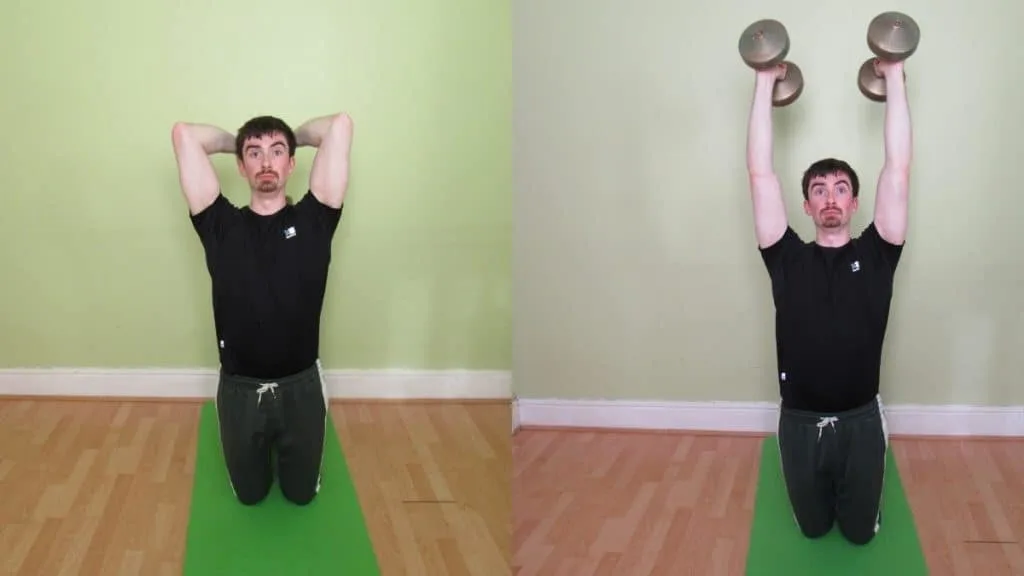
You can do this exercise with the kettlebell overhead extension or the banded tricep extension. But for the demo, we’re using dumbbells since they’re still a more common training tool, especially among those who work out at home.
Performing a kneeling dumbbell triceps extension with two weights enables you to train your triceps independently without performing any extra sets (the main drawback of the one-arm version is that you’ll be doing double the number of sets).
Isolateral exercises like this are ideal if you want to work both of your triceps equally but don’t have the time or desire to do unilateral movements.
Since you’re lifting two weights rather than one, however, you’ll likely have to reduce the total resistance a bit because holding two weights requires more stabilization than holding one weight. So if you can lift 40 lbs on the standard version (where both arms are lifting the same weight), then you might only be able to lift 17.5 lbs per side on this variation.
Half kneeling dumbbell overhead extension
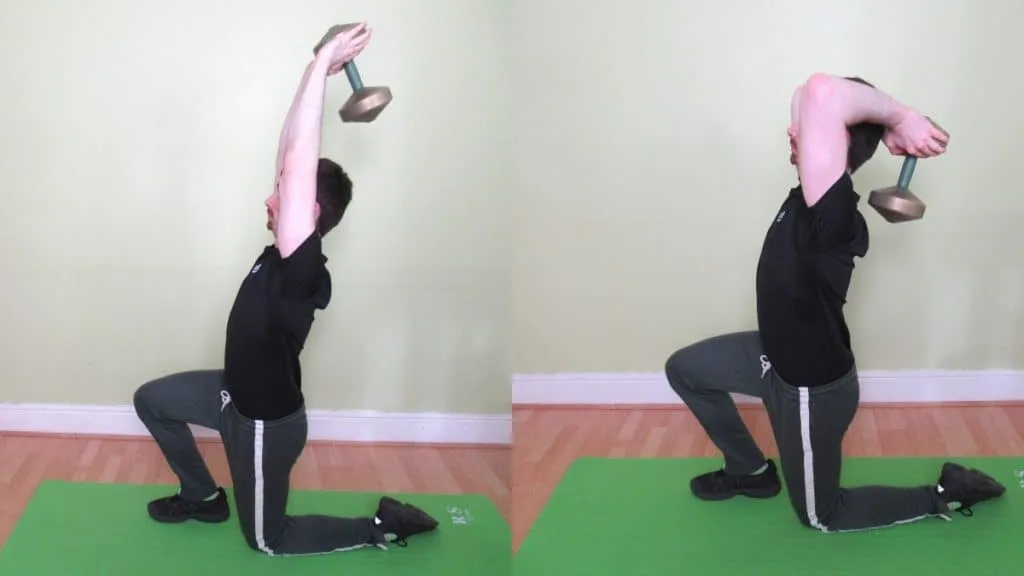
Compared to the tall kneeling variation, the half kneeling overhead extension gives you a more stable base to lift from because having your leg out in front of you helps you to maintain your balance.
The trade-off for this extra balance is that your core muscles—abs and obliques—don’t get as much work, which may actually be a good thing if triceps hypertrophy is your primary goal.
Whatever your reason for doing the half-kneeling tricep extension, just make sure to alternate legs so that you don’t give one of your thighs way more stimulation than the other.
BOSU ball kneeling overhead extension
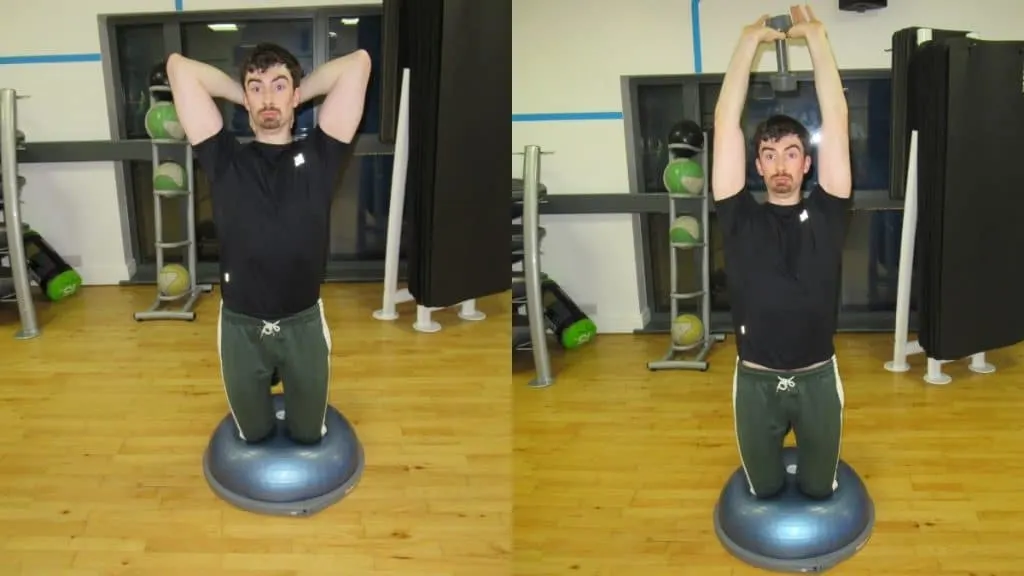
If you want to test your core strength while taxing your tris, then the kneeling BOSU ball overhead extension is the exercise for you.
By kneeling on an unstable surface, of which the BOSU ball is probably the best example, your abs have to work overtime to keep your torso stable. The aim is to keep your hips extended (try not to let them hinge backward) while lifting the weight with your triceps.
This version of the kneeling DB tricep extension has excellent carry over to other exercises that demand a lot of core strength. So if you’re an athlete or someone who’s not just concerned with aesthetics, then it can make sense to train your core in conjunction with your triceps. After all, in most real-life situations, we use multiple muscle groups at once.
Yet, if you’re training for maximum triceps hypertrophy, then you should stick with the standard kneeling overhead extension. But even this exercise requires more core strength than usual, so you might want to do an overhead EZ bar extension in a standing position if you want to keep as much tension on your triceps as possible.
Conclusion: Should you do a kneeling triceps extension with dumbbells?

Although you can do a kneeling tricep extension with a plate and various other training tools, dumbbells are the best option for most people because dumbbells are widely available, relatively affordable, and typically ascend in manageable increments, thus enabling you to gain strength.
The kneeling tricep extension is technically an isolation exercise because the only movement that should occur is at the elbow joint.
Still, your core muscles get a terrific isometric workout from the kneeling dumbbell overhead tricep extension because your abs are responsible for the maintenance of an upright torso position.
Your best bet is to perform the kneeling dumbbell extension in the latter part of your workout so that you don’t fry your core before your more critical, compound lifts, which demand even more abdominal exertion than the kneeling triceps extension.

